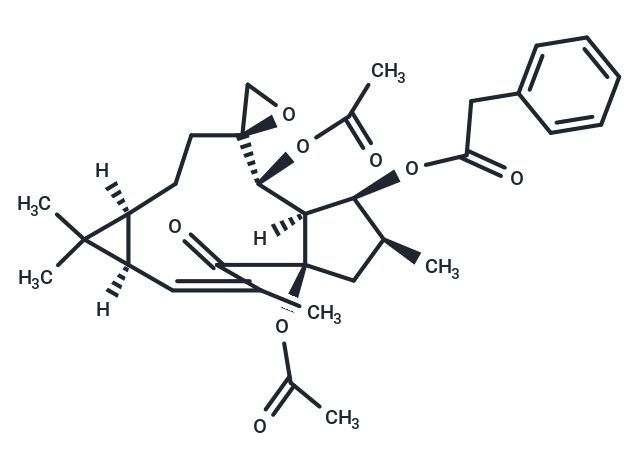Shopping Cart
- Remove All
 Your shopping cart is currently empty
Your shopping cart is currently empty

Euphorbia factor L1 (Euphorbiasteroid) can reduce Bcl-2, PI3K, AKT, and mTOR protein and mRNA levels, and up-regulate caspase-9 and caspase-3 protein levels. It induces autophagy and has anti-cancer, anti-adipogenic, anti-osteoclastogenic, and multidrug-resistant regulatory effects.

| Pack Size | Price | Availability | Quantity |
|---|---|---|---|
| 20 mg | $100 | In Stock | |
| 1 mL x 10 mM (in DMSO) | $80 | In Stock |
| Description | Euphorbia factor L1 (Euphorbiasteroid) can reduce Bcl-2, PI3K, AKT, and mTOR protein and mRNA levels, and up-regulate caspase-9 and caspase-3 protein levels. It induces autophagy and has anti-cancer, anti-adipogenic, anti-osteoclastogenic, and multidrug-resistant regulatory effects. |
| In vitro | Euphorbiasteroid suppresses adipogenic differentiation of 3T3‐L1 cells, mainly at the early stage, and stimulates the AMPK signalling pathway. The anti-adipogenic effects of euphorbiasteroid could possibly be attributed to activation of the AMPK pathway, by decreasing the level of FAS and its up-regulators, including C/EBPs, PPAR-γ and SREBP-1c, without involving insulin signalling pathway[1]. Euphorbiasteroid could be a transport substrate for P-gp that can effectively inhibit P-gp-mediated drug transport and reverse resistance to anticancer drugs in MES-SA/Dx5 cells[2]. |
| Cell Research | 3T3‐L1 cells were treated with euphorbiasteroid at concentrations of 6.25, 12.5, 25 and 50?μM for 2?days in adipogenesis induction medium, 2?days in adipogenesis medium and 2?days in culture medium (CM) sequentially during differentiation. Intracellular triglycerides (TGs) were stained with Oil red O (ORO) solution. |
| Alias | Euphorbiasteroid |
| Molecular Weight | 552.66 |
| Formula | C32H40O8 |
| Cas No. | 76376-43-7 |
| Smiles | O(C(C)=O)[C@]12[C@@]([C@@H](OC(C)=O)[C@@]3(CO3)CC[C@]4([C@@](\C=C(\C)/C1=O)(C4(C)C)[H])[H])([C@@H](OC(CC5=CC=CC=C5)=O)[C@@H](C)C2)[H] |
| Relative Density. | 1.23 g/cm3 (Predicted) |
| Storage | Powder: -20°C for 3 years | In solvent: -80°C for 1 year | Shipping with blue ice. | ||||||||||||||||||||||||||||||
| Solubility Information | Methanol: Soluble DMSO: 37 mg/mL (66.9 mM) Ethanol: Soluble | ||||||||||||||||||||||||||||||
Solution Preparation Table | |||||||||||||||||||||||||||||||
DMSO
| |||||||||||||||||||||||||||||||

Copyright © 2015-2024 TargetMol Chemicals Inc. All Rights Reserved.